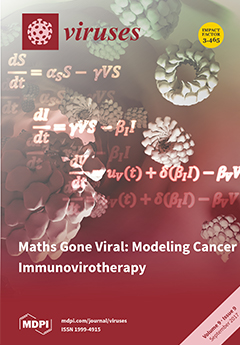Staphylococcus aureus is a commensal and pathogenic bacterium that causes infections in humans and animals. It is a major cause of nosocomial infections worldwide. Due to increasing prevalence of multidrug resistance, alternative methods to eradicate the pathogen are necessary. In this respect, polyvalent
[...] Read more.
Staphylococcus aureus is a commensal and pathogenic bacterium that causes infections in humans and animals. It is a major cause of nosocomial infections worldwide. Due to increasing prevalence of multidrug resistance, alternative methods to eradicate the pathogen are necessary. In this respect, polyvalent staphylococcal myoviruses have been demonstrated to be excellent candidates for phage therapy. Here we present the characterization of the bacteriophage vB_SauM-fRuSau02 (fRuSau02) that was isolated from a commercial
Staphylococcus bacteriophage cocktail produced by Microgen (Moscow, Russia). The genomic analysis revealed that fRuSau02 is very closely related to the phage MSA6, and possesses a large genome (148,464 bp), with typical modular organization and a low G+C (30.22%) content. It can therefore be classified as a new virus among the genus
Twortlikevirus. The genome contains 236 predicted genes, 4 of which were interrupted by insertion sequences. Altogether, 78 different structural and virion-associated proteins were identified from purified phage particles by liquid chromatography-tandem mass spectrometry (LC-MS/MS). The host range of fRuSau02 was tested with 135 strains, including 51 and 54
Staphylococcus aureus isolates from humans and pigs, respectively, and 30 coagulase-negative
Staphylococcus strains of human origin. All clinical
S. aureus strains were at least moderately sensitive to the phage, while only 39% of the pig strains were infected. Also, some strains of
Staphylococcus intermedius,
Staphylococcus lugdunensis,
Staphylococcus epidermidis,
Staphylococcus haemolyticus,
Staphylococcus saprophyticus and
Staphylococcus pseudointer were sensitive. We conclude that fRuSau02, a phage therapy agent in Russia, can serve as an alternative to antibiotic therapy against
S. aureus.
Full article






